

| Circe |
Tuesday, July 7, 2009 As always, I started the project by setting up some staging around the boat so that I could work comfortably around the decks. Then, I moved my gantry crane into position in the shop, as my first goal was to remove the engine and its related components, thus clearing out the dirtiest area of the boat (which had been virtually inaccessible during earlier cleaning efforts). I collected various tools, power cords, lighting, and other things I'd require over the next several days as I stripped the boat back to the basics. Once the staging was set up, I removed the propeller, which went quickly and easily. |
|
With a new interior in the plans and a complete rework of the boat ahead, plus the water and oil damage caused by the boat's flooding that led to this project, I knew that the interior cabinetry was expendable. With access to the engine very tight from all directions, my first step was to remove the icebox assembly from the port side, which would free up important access to the engine and spaces beyond. At some point in the boat's history, the factory-stock icebox unit had been removed, the deck hatch sealed, and a new icebox installed in its stead. Removal turned out to be quick and easy, thanks to the poor construction of the unit, which was only exacerbated by the water saturation that had occurred. The countertop came off in seconds, revealing a prefab fiberglass icebox surrounded by cabinetry made of particle board; the particle board had deteriorated in the wetness, so it pulled apart easily. The pieces were nailed together with common finish nails. In short order, I had the whole mess in the cockpit, and some clear--if filthy--access to the port side of the engine. |
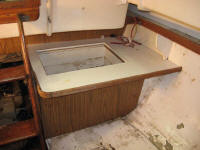

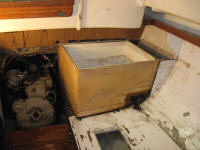 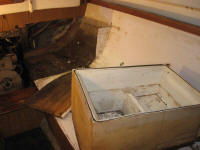
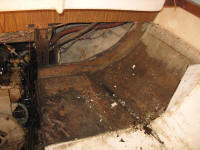
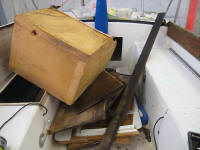 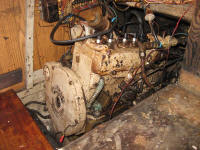 |
|
Next, I unhooked the various things that held the engine to the boat: wiring, plumbing, piping, and exhaust. I cut wires and hoses as needed, and unthreaded the ends of some annealed copper tubing that was part of the raw water system. I removed a battery that was still in place (with one terminal corroded completely flush, probably from stray current when it was submerged), and cleaned up a pile of oily, dirty detritus from beneath the battery box. I cut and pulled out the remaining fuel lines and threw them away, and then attacked the bolts securing the "copper monster" exhaust to the manifold flange. One stud broke, and the other wouldn't budge, so after a brief fight, I gave in and cut the exhaust pipe just aft of the manifold; no one was ever going to use that beast again anyway. The exhaust had been patched at some point in the past. |
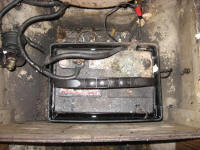
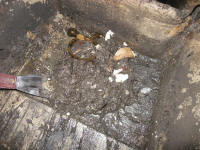
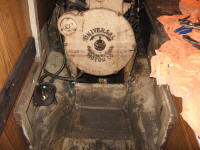 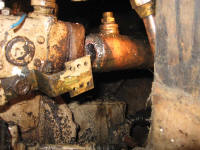
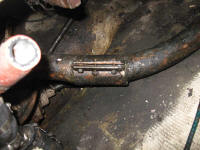 |
|
After consulting with the owner, we decided to install an access hatch in the cockpit sole--good news for me, since access was virtually impossible to the aft end of the engine and the other installations in that general area. With that decision made, I marked out and cut a rough hole for the eventual hatch, though I left the hole a bit smaller than the final opening would be, so that I could make the hole the correct size once I had the actual hatch on hand. But the new, larger hole gave me the access I needed to the propeller shaft coupling bolts, which came off easily. |
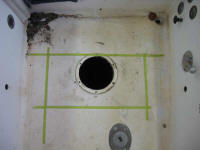
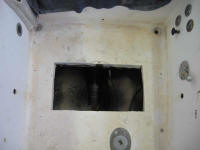 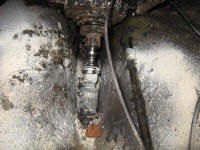 |
|
The four bolts securing the engine to the foundations came unthreaded with relative ease; they'd been well-coated in a greasy mixture over the years. All four came off without a fight, other than the tight access to the after two. |
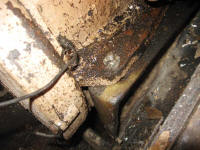 |
|
With that, the engine was unbound from its mountings, and I used the crane to lift it out of the boat and to the shop floor, where I stored it on a rolling cart for the moment. In its place in the boat was a grimy black hole, which I'd need to clean and degrease before continuing much work in the area. |
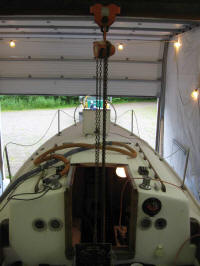 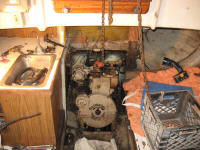
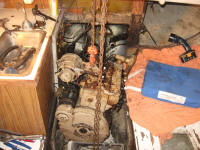
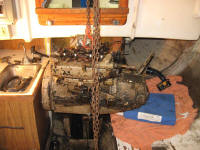 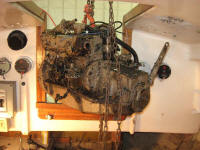
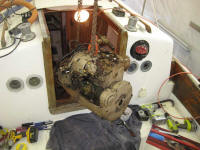
 

 |
|
With the engine out of the way, I removed the "copper monster"--that is, the old jacketed exhaust. In the past, I've gotten these out in one piece, and tried several twisting permutations to make this one come out of the boat easily, but I couldn't get it clear this time for whatever reason. With no reason to waste time on trying to save what amounted to 20 pounds of scrap copper, I sawed it in half and removed it. |
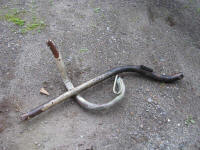 |
|
Next, I turned to the galley sink module on the starboard side. Knowing that the base cabinet would probably come out in one piece, I first disassembled a couple shelves above and outboard of the cabinet, cut the sink drain hose, and undid a few screws that looked like they were holding it in place. These steps were in the right direction, and I soon loosened the cabinet, but found a few places where I had to remove other screws or panels before I could slide the cabinet out of the way. I discovered two very wet rolls of paper towel beneath. |
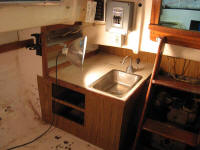
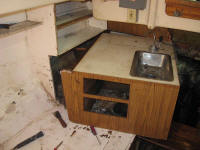
 |
|
After clearing away the latest round of demolition debris, I removed a plywood access panel in the aft bulkhead and worked my way into the starboard locker to remove the engine controls and gauges from the cockpit well; I also unbolted and removed the mechanical shift lever from the cockpit sole. With all the major engine-related components out of the boat now, and the galley completely removed, I decreed the day a success and looked forward to continuing the work tomorrow. |
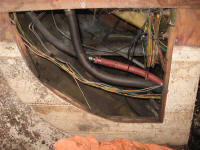
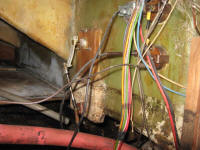
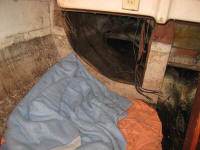 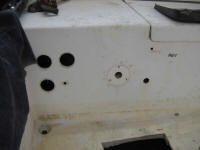 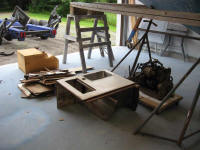
 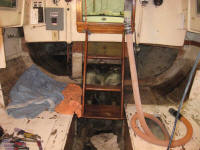 |
|